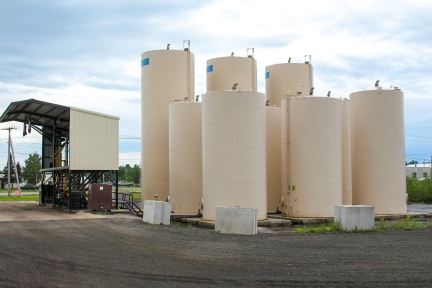
The more than 20,000 regulated aboveground storage tanks (ASTs) in Minnesota store a variety of liquids, from food ingredients to petroleum to hazardous chemicals. Most AST systems — which include tank piping, valves, and containment and loading areas — that contain liquid capable of polluting the waters of the state are subject to state rules and permits. Facilities with tank capacity of less than one million gallons are covered by Minnesota rules; facilities with one million gallons or more of tank capacity are regulated by MPCA permits.
When properly designed and operated, ASTs are very safe. However, ASTs and tank piping can suffer from construction flaws, corrosion, stress, cracking, weld and valve failures, overfills, spills during transfers, and occasionally, tank ruptures. When ASTs leak or spill, the stored substances may flow into lakes and rivers, migrate through the soil to groundwater, or catch fire, thereby contaminating soil, water, or air and posing risks to human health.
The MPCA works with storage tank owners to ensure tank safeguards that prevent leaks and minimize the effects of spills, such as secondary containment, corrosion protection, overfill prevention, and leak detection. The level of protection depends on the type of product stored, and the size and age of the tank.
Exemptions
Some types of ASTs are exempt from the regulations:
- ASTs with a capacity of 500 gallons or less
- farm ASTs
- residential ASTs storing 1,100 gallons or less of motor fuel used for noncommercial purposes
- ASTs holding 1,100 gallons or less used to store heating oil for on-site consumption
- wastewater treatment equipment
- tanks storing substances used for operational purposes, such as integral hydraulic lift tanks, lubricating oil reservoirs for pumps and motors, and electrical equipment
- ASTs containing hazardous wastes subject to a treatment or storage permit
- stormwater collection systems and septic systems
- ASTs containing agricultural chemicals regulated under Minn. Stat. §§ 18B, 18C, 18D
- vehicles such as tank trucks or railroad cars designed to transport substances, unless stationary for more than 30 days
- water tank
- ASTs with a capacity of 1,100 gallons or less that are not located within 500 feet of Class 2 Surface Water
- compressed gas tanks
- stainless steel tanks containing anything other than a petroleum product or hazardous substance
- surface impoundment, pit, pond, or lagoon
Tank notification
Owners of ASTs with a capacity of 500 gallons or more that contain petroleum or hazardous substances used commercially must notify the MPCA of the existence of the tanks.
- Facilities with storage capacity less than 1 million gallons
- Major facilities with storage capacity of 1 million gallons or more
Out-of-service tank systems
Tank owners must continue to follow AST requirements for inactive tanks until completing closure procedures, including:
- removing the product, sludge, and residue
- cleaning and degassing the tank
- bolting all manways and valves
- blinding piping
- labeling the tanks as out of service
A closed tank cannot be reactivated until it's inspected and leak tested. When an AST is dismantled or removed, with some exceptions, the area under the tank must be sampled for contamination. The petroleum cleanup guidance has a number of guidance documents that may be helpful.
Temporary tanks
Tanks that store product for more than 30 days but less than one year are considered temporary tanks. They must be labeled, have a facility sign posted, provide secondary containment, and be maintained.
Indoor tanks
Aboveground tanks located in enclosed structures that meet certain criteria are exempt from Minnesota rule, though indoor ASTs that hold 500 gallons or more must be registered. The indoor tank must rest on or elevated above an impermeable floor. In addition, if the entire contents of the tank is released, one of three things must be true:
- the release is contained in a specific secondary containment structure (which may include a double-walled tank)
- the release is contained by the building — the tank contents couldn't escape through doorways, floor drains, or other means
- a drainage system would direct the release to a permitted wastewater treatment facility